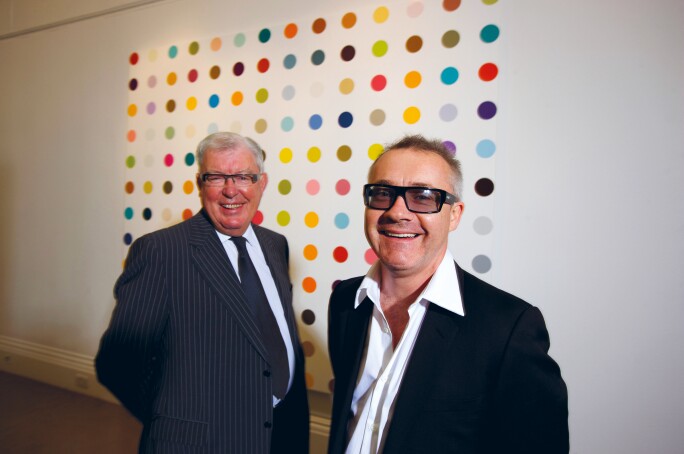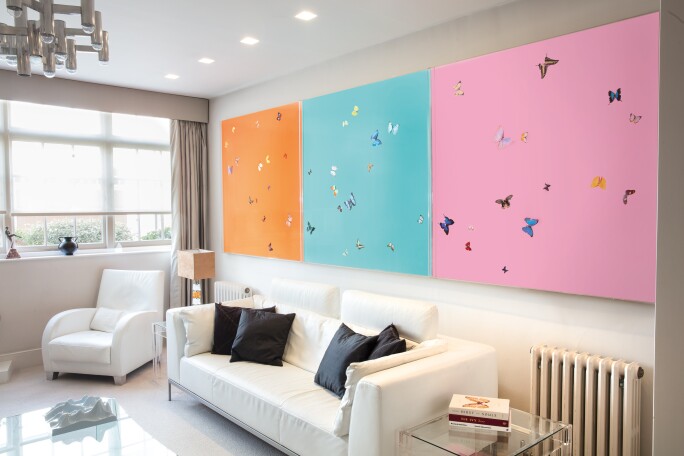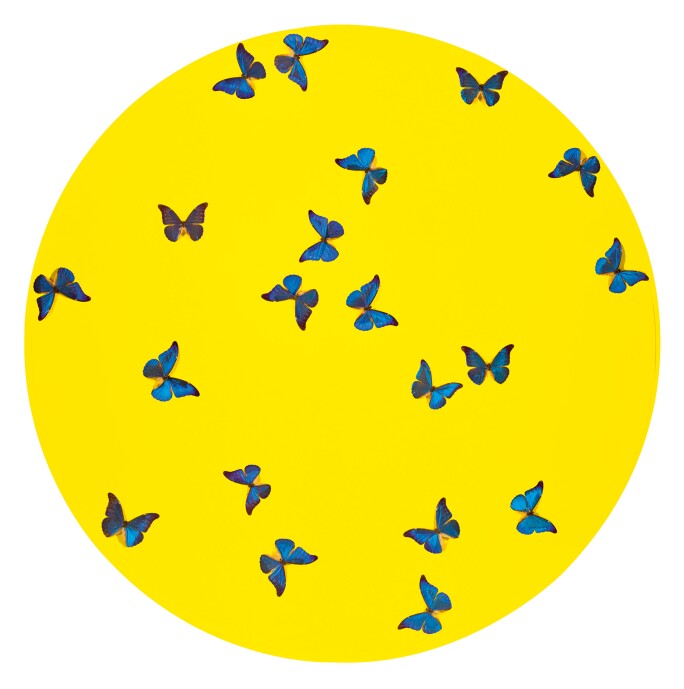W hen the entrepreneur Frank Dunphy worked with Damien Hirst, between 1995 and 2010, their achievements in the business of art became almost as legendary as the work Hirst produced. There was the Pharmacy auction at Sotheby’s in 2004, when the fixtures and fittings of Hirst’s west London restaurant sold for £11.1 million; and Beautiful Inside My Head Forever, a sale at Sotheby’s that made £111 million in 2008, just as the global financial crisis began.
The pair’s relationship changed Hirst’s life, and impacted the art world much more widely. Meanwhile, Dunphy and his wife, Lorna, quietly amassed a collection, including gifts from artists and works acquired through galleries and auctions.
Talk to the artists whose work Dunphy has collected – many of their pieces feature in Yellow Ball, the sale of the Dunphys’ collection at Sotheby’s on 20 September – and they will speak fondly of him as a great entertainer. The London art scene “didn’t know what had hit it”, says Peter Blake, “because here was this affable Irishman telling jokes, and suddenly all hell broke loose”.
Dunphy’s approach was unusual because, as Blake says, “before he was with Damien, Frank was a financial adviser to people like Coco the Clown”. At the Royal College of Art, Blake wrote in his thesis about the club owner Paul Raymond “putting nude shows into the music hall”, describing a naked performer who was forbidden to move on stage but “would sit on a bicycle and be pushed across it, so she wasn’t moving but the bicycle was,” Blake recalls. “She was called Peaches Page – and Frank was her agent.” Now, when the longtime friends meet, “whoever he comes up with, I know about; all the clowns and the music hall”. The auction includes Blake’s Ms Super • (1987), a depiction of a wrestler from the music-hall era, depicted in gouache, watercolour and collage, with a glittering frame.

Photo: Martin Beddall / Alamy Stock Photo. Artwork: Damien Hirst and Science Ltd. All Rights Reserved, DACS 2018
Dunphy brought an unorthodox approach to the art world, questioning the traditional gentlemen’s agreement between artists and galleries whereby each received 50% from sales of works. “It wasn’t the law, but it was how things worked,” Blake says. “Frank burst into that, saying: ‘It doesn’t have to be like that.’” Dunphy “subverted the system and played [Hirst’s galleries] like mad against each other”, Michael Craig-Martin says. “It was really quite brilliant. Damien’s intention was always to play the system in favour of the artist. It was when he realised how much money other people were making out of the art that he became interested in doing the same."
The London art scene “didn’t know what had hit it”, says Peter Blake, “because here was this affable Irishman telling jokes, and suddenly all hell broke loose”.
Dunphy arrived at the right time, just as the 1990s contemporary art boom kicked in. “He was a really good energy around the middle years of the Young British Artists: people were starting to make money and he gave good advice,” Rachel Whiteread says. Dunphy helped the artist to acquire the former synagogue in Shoreditch, east London, that became her studio. “He helped with getting that organised, and a bit above and beyond,” Whiteread says. In return, she gave him a sculpture – Untitled (For Frank), 1999 – from her series of casts of bookshelves. It was one of six works belonging to the Dunphys that are being gifted to Pallant House Gallery in Chichester, southern England, this year.
The auction includes another sculpture by Whiteread: Junk Food, 2007, created for an auction for a Parkinson’s disease charity, in support of Fergus Henderson, the chef behind London’s St John restaurant, who has Parkinson’s. It consists of the casts of a disposable coffee cup, aluminium takeaway containers and a pizza box. “I often do this with things for [charity] auctions; it was tongue-in-cheek,” Whiteread says. “The joke was that nothing could be further from Henderson’s nose-to-tail approach; it was the antithesis of what he did.”
Whiteread did not realise until recently that the Dunphys had acquired the piece. But they have bought often at charity auctions: they acquired Craig-Martin’s Scissors (wallpaper pink), 2004, in the Ferguson sale; and in the Red auction at Sotheby’s in 2008, organised by Hirst with U2’s Bono to raise funds to combat Aids in Africa, Frank paid $418,000 for Peter Blake’s red collage LOVE, 2007, for Lorna.
The couple’s collection also included similarly bold works such as Gavin Turk’s Dump, 2004, a lifelike rubbish bag cast in bronze. The work had been installed in the Dunphys’ dining-room, and Lorna said: “You could see guests looking at it and thinking: ‘You’d think they’d move that!’” Turk’s work in the Yellow Ball auction subverts the idea of the ownership of art: it riffs on Alighiero Boetti’s text tapestries, but spells out Turk’s name. “It’s playing with the idea that this is possibly what all the art is doing,” the artist says. “It’s a shorthand for the collector having collected these signatures.”
Turk says that Dunphy’s taste “was crystallised by looking at what Damien was looking at, and then starting to find his own pleasure in art”. Given that Dunphy’s association with Hirst “cast him into the most sophisticated level of the art world”, it made “enormous sense” for him to become a collector, Craig-Martin says. “He must have been making a lot of money, and where better to put it than into the world about which he had become extremely knowledgeable?”
It is the fruits of that knowledge, and of the personal relationships Dunphy developed, that will be sold in September.
Ben Luke is a regular contributor to Sotheby’s magazine.
Yellow Ball: The Frank and Lorna Dunphy Collection will be on view in London from 14–20 September. Auction: 20 September.
Yellow Ball: The Frank and Lorna Dunphy Collection Online will be on view in London from 14–20 September. Auction: 11–21 September.





